
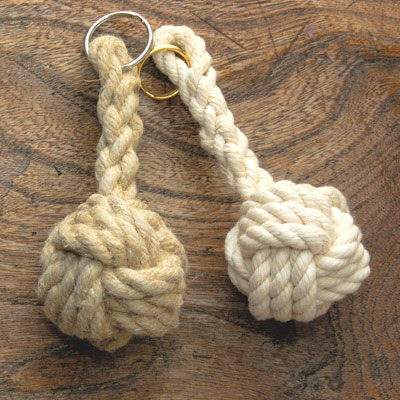
ROPE KEY RINGS
New high quality natural fibre cords and ropes in 4mm and 8mm three strand cotton and / or hemp were used to make these rope key rings. All based on traditional Sailor's Knots, they represent a small selection of what is possible.
Rope Key rings make wonderful nautical themed gifts. You can order any of these from us or learn to tie them yourself. For anyone who is interested in the craft of knotting, have a look at what we get up to at our Knotting Workshops, or contact us for more details.
Monkey Fist Key Ring
The Monkey's Fist is made from a single length of rope or cord followed and worked around the traditional pattern. These ones measure approximately 6 inches long (15cm).
The pattern can be followed around twice, three or more times depending on the size of the monkey fist required, then - using the fid, the rope is gradually and neatly pulled together to make the knot tight. At the long end the rope is looped around a brassed or chromed split ring, and the (unlaid) strands spliced back along the lay.
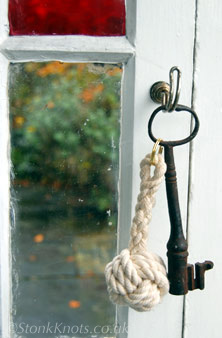
A Monkey Fist knot is a traditional sailor's knot, commonly tied around a stone, lead or glass ball and used at the end of a boat's heaving line as a weight to carry the rope forward when it is cast.
The topology of this knot links in three directions, represented as interlocking circles. When tied in the form as illustrated, using a good hard laid rope, it holds its own shape nicely without a core.
The Monkey Fist knot is not the easiest to master: after the initial pattern is set, the real skill lies in being able to neatly follow the pattern three times around and make a ball shaped knot with no distortion.
The Monkey Fist Knot provides a handsome end to a long cord lightpull and makes an original button and loop rope curtain tie-back.
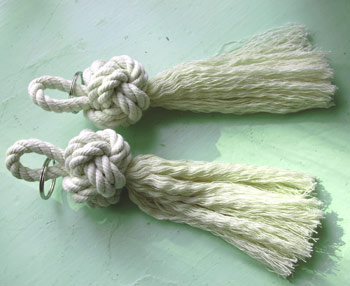
The Diamond Knot
The Diamond Knot is a very old knot according to The Ashley Book of Knots - first mentioned in 1769 and originally used in jib-boom footropes. A diamond knot is often tied into the middle of a rope and can be made from two or more strands of the rope.
These Double Diamond Knot Key Rings were each made from a single length of 8mm cotton rope which is looped over to create two 'strands'. The pattern of the knot was followed twice around (doubled) and the ends unlaid and combed into a tassel. The length of this keyring is approximately 5 inches (13cm).
A more intricate eight strand version can be seen here tied decoratively into a Ship's Bell Rope.
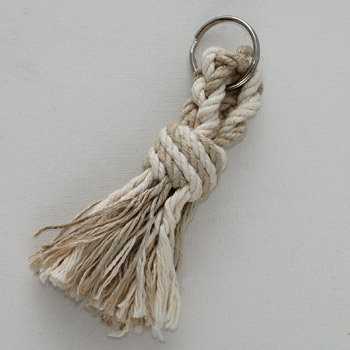
The Matthew Walker
The Double Matthew Walker Knot will not slip or capsize. It is an easily formed knot but, like the Star Knot, is hard to set fair.
This knot is one of the few knots to be named after a person; The Ashley Book of Knots relates the story of a sailor who was sentenced to death by a judge - himself a sailor in earlier life.
Because of their common fellowship of the sea, the judge offered the sailor a full pardon if he could show him a knot that he, the judge, could neither tie nor untie. The fortunate Matthew Walker came up to the challenge, secured his pardon and provided the world with an excellent knot.
The Matthew Walker keyring shown here used three strands each of 4mm hemp and cotton rope and measures approximately 4 inches (10cm).
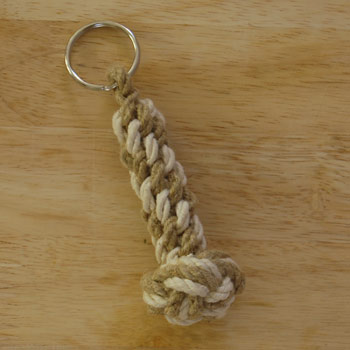
The Manrope Knot
The Manrope Knot is a smart stopper knot tied into the end of a line which effectively prevents the rope from unravelling. At sea the Manrope Knot was tied in the manropes which lead to either side of the gangway.
Using the individual strands of the rope, the Manrope on Crown Sennit Keyring is constructed by forming a Wall Knot, then a Crown Knot on top of the wall, then following round the Wall, then following round the Crown!
The Manrope knot keyring shown was made using two lengths of 4mm hemp cord, which were crossed over each other and worked as four separate strands. The Manrope and Crown Key Ring measured approximately 4 inches (10cm).
They are still used as practical end knots on a handrail or stair rope. You can see how to put in a manrope knot at the end of a 24mm hemp rope on our working with ropes page.